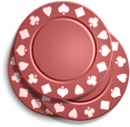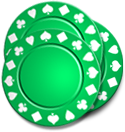



Poker is much more than a card game or even a money game, it is a game of psychological warfare. Obviously stronger hands win showdowns but you have to decide if you actually have the strongest hand before betting the house on it. There are many ways to tell the mind-set of a poker player as all players have different involuntary actions to observe. Some key aspects to identifying poker tells including; card handling, chip handling, eye movement, body language and betting behaviour.
What an opponent does with their hole cards is often a good place to start looking for tells. If a player takes a quick look at their cards then instantly places a large bet then they will probably have a strong hand or they are attempting to bluff. When players look at their hole cards after the flop is dealt there's a good chance that they're looking for a flush or a straight, if they had strong hole cards like AA, AK, AQ, KK etc they would most likely remember these cards when looking for pairs and sets (3 of-a-kind).
Studying players chip handling techniques is another good way to identify tells. When a player uses their higher value chips to place bets into the pot it is often an indicator that they have a strong hand (or they are bluffing the same concept), equally if the player uses smaller value chips then they may have a weaker hand. When a player throws chips into the pot forcefully or aggressively they may have a strong hand or are attempting to convince you that they have. Sometimes a player will make smaller stacks within their own stack which can identify how the player intends to bet. For example, if a player is making blind-sized stacks then they are likely to call a lot of hands.

Players will often obscure their eyes with sunglasses and caps to prevent other players from observing their eyes. This is because your eyes are very difficult to prevent from reacting to your frame of mind. As a rule, if a player looks up and to their right (your left as you look at them) they will most likely be creating a thought (or lie) in their mind as opposed to a player who looks up and left, who will most likely be recalling an actual or truthful thought.
A player's posture will also tell information about them. If a player is leaning forward they are likely to be excited and keen on studying the table whereas players who lean back in a more relaxed manner are exactly that. It is very difficult to identify tells from posture alone but used in conjunction with other tell signs it can confirm your suspicions. Some players freeze when they see their cards, this is often done by players with strong hands in an attempt to go unnoticed until it is their turn.
Tells are rarely an absolute indicator of a players hand. Most tells give you an insight into a player's hand but they are not a guaranteed reflection of the hand they possess. You should make any decision based on all factors including tells. If you notice an opponent's tell, do not let the player know that you know the tell, only a novice would do this as it concedes any advantage gained from such knowledge.

